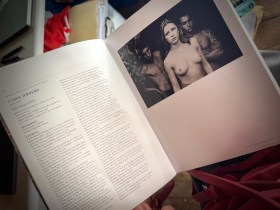Stuart MacDonald ran a piece recently in The Sunday Times, reporting the views of Alexander Stoddart, the Queen’s newly appointed Sculptor in Scotland. Under a shameless headline, his sub-head declared “Modern art is under fresh attack”. Stoddart is quoted, railing against the Scottish National Galleries: “The National Galleries hit a new low when they trucked with that woman,” meaning Tracey Emin, who exhibited there last summer.
I just wonder how many times we all need to revisit this old chestnut. Modern art is always under attack. It’s an easy target, as I know from experience. Been there, done that. Referring to the last two decades, Stoddart claims that false culture has gone hand in hand with false money and singles out the work of Emin and Damien Hirst as poverty-stricken objects. Well, he may be right and I happen to agree with him, but I’ve also long since accepted that art is anything you can get away with. Duchamp started it, many have followed. Indeed, of all pieces, his Fountain topped a poll of 500 art experts five years ago as the most influential work of modern art. Most people might be more comfortable with Picasso’s Les Demoiselles d’Avignon, which came second, or Andy Warhol’s Marilyn Diptych, placed third. But no, the experts voted for a signed urinal and who knows, perhaps they were right, given the legions of “modernist rubbish” that it spawned. I’m quoting Stoddart again. He’s a sculptor and doesn’t seek to shock with outrageous or navel-gazing installations, which is why Gormley is a household name and Stoddart isn’t. Of Gormley’s major work last year, critics yet again questioned its value and historical relevance. “This is not art: it’s an Arts Council-inspired directive on how to reach out to the community,” (Lilian Pizzichini), and “If Gormley really is modern Britain’s idea of a provocative, serious artist … we’re as remote from the cutting edge as Britons in the 1950s who took Henry Moore, that third-rate imitator of Picasso, to be an important modernist,” (Jonathan Jones, having a go at two for the price of one).
It’s a critic’s job to criticise. Criticism which explains how and where improvements can be made is a requirement in most disciplines, although it is always important to be constructive, never brutal. Certainly never flippant nor casually damning. My field was an applied, practical branch of the arts in which designs can be judged a success or a failure depending upon whether they work or not, and of course it always helps if the results are things of beauty too. But fine art is a different animal. It has only to work on an individual level to be successful” one man’s meat, and all that. It’s not surprising that people’s views and appreciation of art differ wildly but it rocks the boat from within when a top practitioner ‘goes public’ as Stoddart does in lambasting the usual suspects. This behaviour would be considered unprofessional between architects. Sadly it’s nothing new in fine art.
Stoddart’s outburst doesn’t parallel the Establishment having a swipe at the upstart refuseniks, because today’s usual suspects are at the very centre of the Establishment. They are the popular ones, lauded, applauded and rewarded, their names remembered by those with false money wanting to buy some false culture. Their success is due in no small part to their marketing strategies and business plans. PR is vital and of course there is no such thing as bad news or reviews. Maybe this is what Stoddart is banking on.
Today’s art Establishment is all-embracing, but the Queen’s new Sculptor in Scotland demonstrates that it has bitter rifts deep within. He is angered by the crassness of popular taste and no doubt also by the telephone number prices that are needed to acquire the works of its pedallers, particularly the installation pieces. However, his new job is the hardest of them all. Now that he has found royal patronage, he can’t hide behind the artist’s default veil of ‘I’m just doing it for myself’ but runs the risk of mass criticism on a national scale if his work turns out to be anything other than ‘safe’. What self-respecting artist would ever get himself into such a situation? And what journalist would want to run with verbal dissing, as if it were outrageous? No, it’s de rigeur.
Gregor Muir, who coincidentally shares his name with my dentist, has just written a book that supposedly charts the rise and fall of the YBA, although it seems fair to bring the critics in again here as at least one suggests that it might actually be a rather incoherent study of Muir’s own career. Anyway, if he’s right and the movement has already fallen, I’ll be most upset. What will I now do with that molar that Gregor pulled a few years back? I wanted to encrust it with diamonds and stick it on ebay. Or to put it another way – I fancied making a fortune from a piece of junk. The problem with this scenario is that the only way I’d be taken seriously is if I’d dropped out of art school, was dossing in a garret in the East End, and permanently out of my head on crack cocaine.
Oh dear, there I go again. Just can’t pass up an opportunity.

_Encounters-in-Reflection_Gallery3BPhoto-by-Anpis-Wang-e1745414770771.jpg?w=280)


